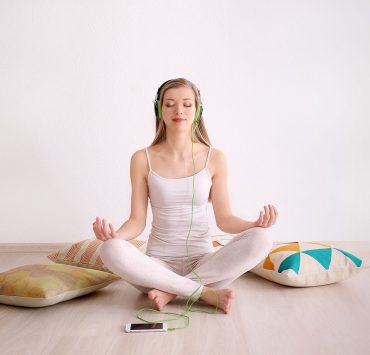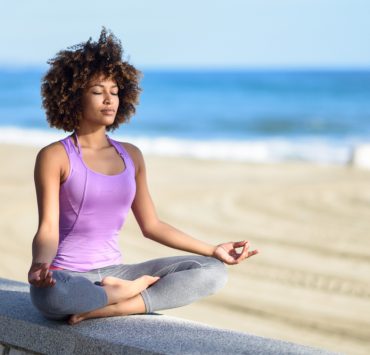
Andrea has been hosting yoga retreats in various locations worldwide…
All around the globe, spiritual seekers are retreating into silence to take a better look at the nature of reality – and they are doing so not just for a few days. Many are choosing to disconnect from the outer world for a more substantial length of time, retreating into a world-renowned practice called Vipassana for ten full days of silence. Whether the concept frightens or inspires us, it certainly intrigues us on a deeper level. Within a constantly buzzing modern world, silence is largely foreign to us, as is the practice of looking within. We can only wonder: what would ten days of silence be like? What would arise within ten days of inner observation? Those who have practiced might be able to suggest what the experience is like; otherwise, we might consider making the descent into this ancient meditative practice ourselves.
What is Vipassana Meditation?

Vipassana meditation, also referred to as insight meditation, is an ancient Buddhist practice that calls us to pay close attention to any and all sensations that arise within us. It is a meditation practice based on observation that facilitates an expansive exploration of both mind and body, coming from a place of compassion and openness. Vipassana helps to purify the mind, reconnecting us to a deeper sense of joy and contentment, regardless of outside circumstances.
Vipassana meditation is not an intellectual journey but an experiential awakening. Amit Ray
In day-to-day life, we often operate unconsciously, believing our thoughts to be fact and becoming highly identified with our emotions and other feelings. Vipassana meditation helps us to see through these mental processes, helping us to gain clarity about the laws that influence our feelings, thoughts, judgments, and experiences. What we gain is a deeper sense of awareness about who we are and a greater sense of contentment and inner peace.
The main intent of Vipassana is to practice observing things exactly as they are, not as they appear to be. In this way, the practice offers insight into ultimate truth, exposing relative truth and helping to liberate us from the suffering we experience because of mental impurity, negativity, or uncontrolled thoughts. Vipassana is a path into impermanence, absence of ego, and suffering.
The practice is not about pushing away thoughts that arise; it is about non-judgmentally witnessing them. In Vipassana, both positive and negative thoughts and sensations are held within a wider field of awareness. Concentration is the primary tool used in this practice, a necessity for seeing through any illusions created by our thoughts. Overtime, the practice of Vipassana helps to expose untruths that hold us back from peace, contentment, and enlightenment.
History of Vipassana

Vipassana meditation has a long history, having originated over 2500 years ago. At this time, it was rediscovered and practiced by Gotama the Buddha, leading up to his enlightenment in 528 BCE. He began to offer his teachings and techniques with others, a practice now known to be the origins of our modern day practice of Vipassana.
Vipassana practice took roots in India before spreading to neighboring countries. When it disappeared from India, it continued to hold ground in Burma (or present day Myanmar). Since then it has reestablished itself in India and has inspired humans all around the globe.
In the early 1900s, colonialism sparked the reemergence of Vipassana in Burma. It was then that the practice became popularized, being extended to people of all walks of life, monastic or not. Ledi Sayadaw was the monk who held the lead role in bringing new life to this ancient practice. He offered Vipassana meditation in a simple way that could be incorporated into an average person’s everyday life. No longer was it necessary to escape everyday life to gain powerful insights; now, anyone could explore these teachings.
About half a decade later, S. N. Goenka (born in Myanmar) reintroduced Vipassana practice in India. He learned the practice from Sayagyi U Ba Khin who, in 1969, appointed Goenka to teach this ancient practice. People began to travel from all over the world in the 1970s to be taught by Goenka and in 1979, he offered the first international Vipassana coure in Gaillon, France.
Over the next few years, Vipassana spread overseas, with international institutes opening in the United States and Australia. Since then it has become a world-renowned practice and a sought after teaching with institutes all around the world.
Benefits of Vipassana

With the primary objective being mental purification, the benefits of Vipassana are widespread, holding life changing potential. The psychological benefits of the practice include greater peace of mind, stronger will power, and greater focus and clarity. Vipassana helps to improve emotional regulation and balance, lowers stress, anxiety, and depression, and enhances cognition. Overall, this practice facilitates mental, emotional, spiritual, and physical healing and promotes maintenance of holistic wellbeing.
Spiritually, Vipassana helps to connect one to their true nature. Once again, it sheds light on our relative sense of truth and holds the capacity to expose the ultimate truth – or an ultimate reality. Our view of the world and ourselves expands through Vipassana practice as the mind quiets and we become more highly attuned to the present state of things. Vipassana helps us to see through our thoughts, exposing the cognitive patterns that predominate. Through continued practice, Vipassana can also strengthen intuition, offering powerful insights that are applicable to the everyday human life.
In addition, research suggests that Vipassana meditation courses are effective in reducing substance abuse and related issues. Neurological explanations suggest that meditation such as is offered through Vipassana teachings helps the individual to establish alternatives to compulsive behavior. In prison settings, Vipassana meditation also shows promise as an effective tool for reducing recidivism and psychopathological symptoms among inmates. Vipassana was brought into prisons in India in the mid 1970s, and since then it has touched inmates all around the world.
Vipassana Meditation Centers and Retreats

Numerous centers exist all around the world for those looking to study and practice Vipassana meditation. From Asia and the Pacific to the Americas, Europe, the Middle East, and Africa, individuals can travel far and wide to gain the insights available through this ancient practice.
There are both ten-day courses and shorter ones, but beginners must first complete a ten-day course before being able to participate in the others. Over the course of ten days, the technique is taught and practiced. Days begin at 4:00 am with a morning bell, followed by two hours of meditation. After breakfast, there is another stretch of time for meditation (both in a group setting and individual). Between lunch and dinner, plenty more meditation space is offered, in silence of course. There is opportunity for rest, and time for you to speak with your teacher – this is the only exception to vocal silence. Discourse is offered in the evening, following by additional meditation. The day wraps up by 9:30pm.
Breath is the bridge which connects life to consciousness, which unites your body to your thoughts. Whenever your mind becomes scattered, use your breath as the means to take hold of your mind again. Thich Nhat Hanh
There are five precepts that ten-day course participants must abide by while on the retreat. While on the course, it is mandatory to abstain from killing any being, from stealing, from all sexual activity, from telling lies, and from intoxicants. Participants must also be willing to follow the course outline throughout the entire stay. Strict adherence to meditation techniques is required. All other spiritual practices must be refrained from.
There are no upfront costs to a Vipassana meditation; retreats are offered by donation. This helps to make the teachings accessible to anyone and everyone, regardless of financial circumstances.
How to Practice Vipassana Meditation at Home

It is highly recommended that if an individual is deeply interested in understanding the powerful practice of Vipassana meditation, they should first receive authentic teaching at a Vipassana Center. Once one has undergone the intensive experience, the practice can be continued at home.
To gain an understanding of the Vipassana approach, you can practice the following technique.
- Come to a comfortable seated position with your legs crossed and back straight. If this is inaccessible or uncomfortable, you may sit in a straight-backed chair.
- Close your eyes and draw your awareness to your belly. As you breathe, become aware of the sensations that are present. Retain awareness of and focus on every aspect of the breathing process – from rising to falling of the stomach, and including all of the phases in between.
- If the mind wanders, become more aware of the thoughts that are arising. To avoid becoming entangled in the thought, simply observe that you are thinking and return to the breath.
- Other sensations may arise, such as physical sensations, sounds, and visions or imagery. Focus your attention there and apply an appropriate label, such as “smelling,” “visualizing,” or “hearing.” Observe sensations in the same way by noting, “cold,” “tightness,” or “movement.”
- Sit for one hour or longer, addressing every sensation in such a way as you sit in stillness and silence.
- To end your practice, note the transitions of your concluding the meditation in the same manner, labeling with words such as “thinking,” “adjusting,” and “opening.”
- Allow this practice to extend into other areas of your life, observing everyday actions with the same clarity and precision.
Vipassana is a way of training the mind to access deeper insights than our rational and conditioned selves have the capacity to reach. As we practice, we become better at observing reality for what it is and what it is not. This meditation practice opens us up to what exists beneath our identity, our conditioning, and our ego, offering us the opportunity to get in touch with the fundamental nature of our existence. Through this practice, enlightenment is possible.
What's Your Reaction?
Andrea has been hosting yoga retreats in various locations worldwide since 2003 and continues to encourage her students to live as the best version of themselves. Yogic living provides the framework for her informative writing, which is chock-full of beneficial tips and tricks.














